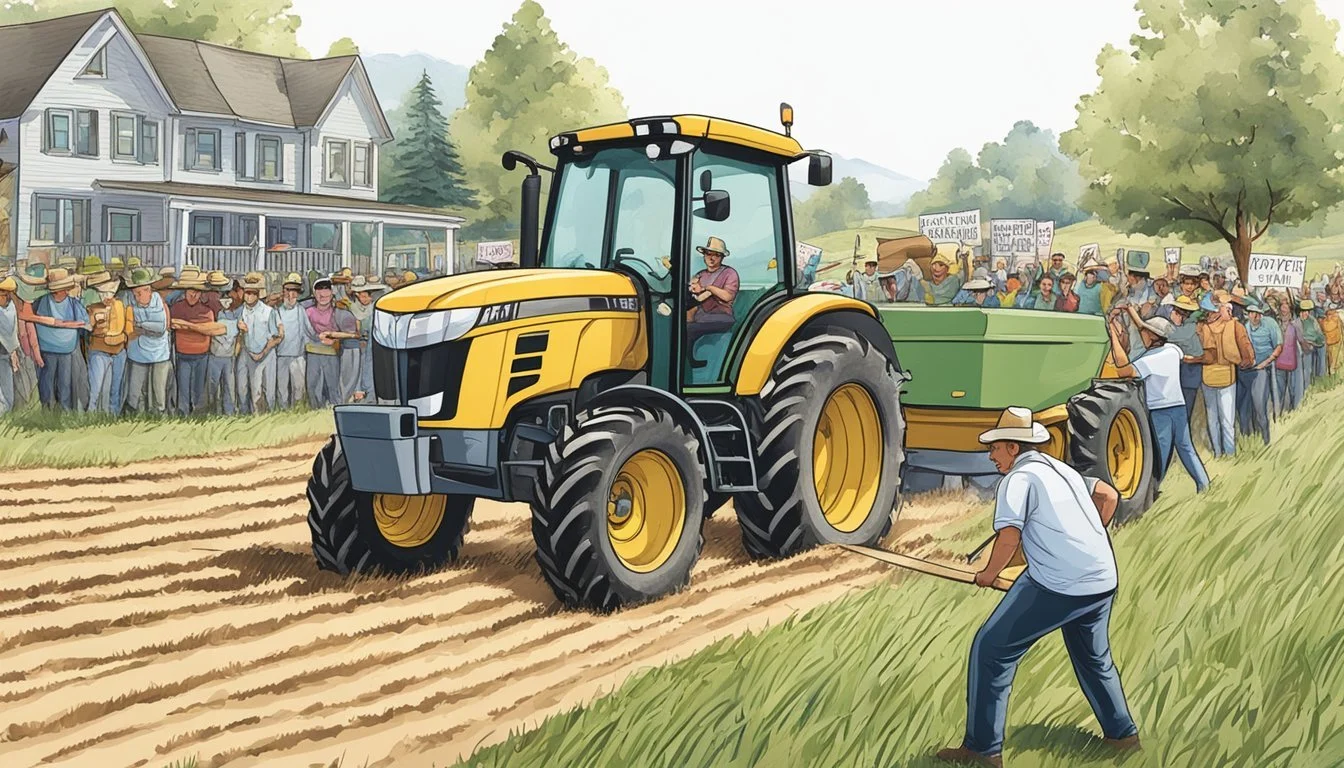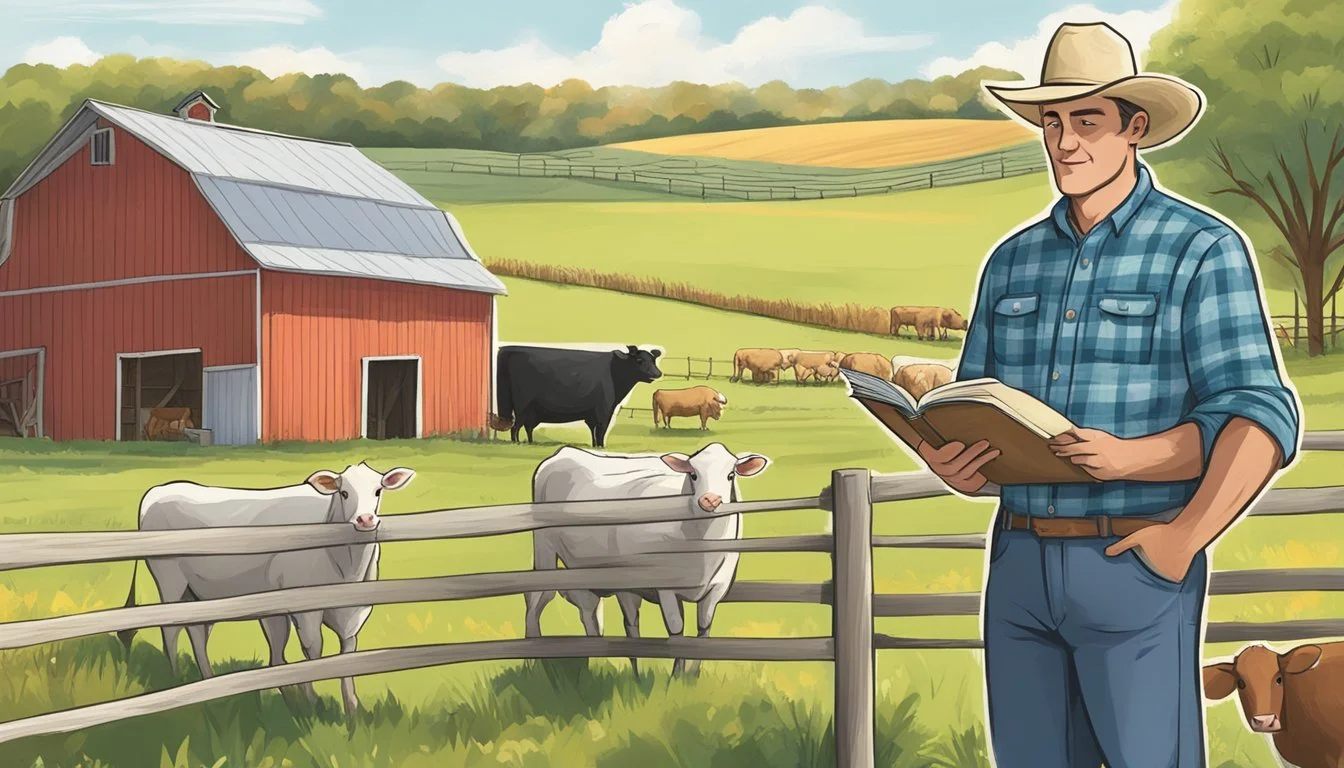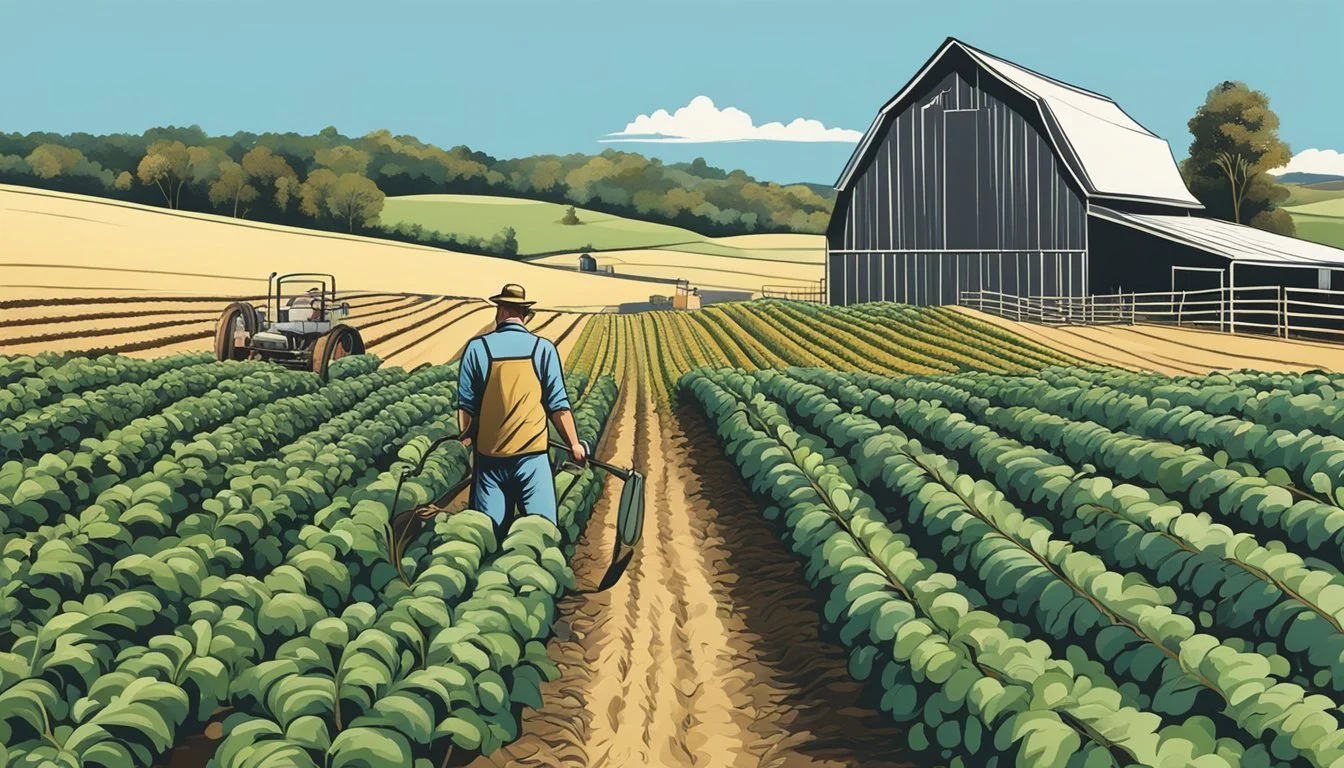Right to Farm Law in Kentucky
Understanding Agricultural Protections
The Right to Farm Law in Kentucky is designed to protect and promote agricultural operations by providing legal defenses against nuisance lawsuits. Enacted in 1980, Kentucky's Right to Farm statutes aim to encourage the conservation and improvement of agricultural land. They grant farmers immunity from nuisance claims in certain situations, acknowledging that agricultural practices can sometimes cause discomfort or inconvenience to non-farming neighbors.
As agricultural landscapes evolve, Kentucky has seen significant changes in its farming dynamics. There has been a decrease in both the number of farms and the acreage of farmland since the law's initial passage. Despite these changes, the law's intention remains to balance the interests of agricultural producers with those of their surrounding communities.
Kentucky Revised Statute 413.072 forms the basis of the state's Right to Farm laws. These laws underscore the importance of agriculture to the economy of Kentucky and the well-being of its residents while providing a framework for resolving conflicts that arise when non-agricultural land uses encroach on farm operations. In doing so, the statutes safeguard farmers from legal challenges as long as they employ reasonable and lawful farming practices.
Historical Context of Right to Farm Laws
Right to Farm laws have evolved as a legislative response to the conflicts arising from urban sprawl on agriculture. These statutes embody a state's commitment to preserving its agricultural heritage and minimizing the legal challenges faced by farmers.
Evolution of Right to Farm in Kentucky
Kentucky, alongside other states, experienced a shift in land use patterns as cities expanded into rural areas. This led to increased conflicts between new residents and existing farming operations. Right-to-farm laws in Kentucky were enacted to protect farmers by affirming their right to engage in agricultural practices without the threat of nuisance suits. Over time, these laws have been amended to reflect the changes in the agricultural sector and to safeguard farmers effectively.
National Impact on Kentucky Laws
Researchers and authors have noted that the evolution of Kentucky's right-to-farm laws has not occurred in isolation. Influenced by nationwide movements and the work of institutions such as the National Agricultural Law Center, Kentucky's statutes have been shaped by national trends. Across the U.S., legislation at the state level has been enacted following similar patterns, aiming to ensure that farmers can rely on a consistent legal framework to defend their practices under common law. Kentucky's adoption and adaptation of right-to-farm laws reflect a broader national ethos, emphasizing the significance of agriculture to rural economies and the domestic food supply.
Key Features of Kentucky's Right to Farm Law
Kentucky's Right to Farm Law is designed to support and protect the agricultural community by establishing certain legal provisions and protections for farming activities. These features play a crucial role in maintaining the balance between agricultural practices and the interests of the non-farming population.
Statute Provisions
Ky. Rev. Stat. Ann. § 413.072 serves as the foundational statute for Kentucky's Right-to-Farm Law. This statute lays out specific provisions that aim to conserve and promote agriculture within the state. Since its enactment in 1980, the law has undergone amendments to adapt to the evolving landscape of farming.
Key provisions include:
The acknowledgement of agriculture as a vital activity within the Commonwealth of Kentucky.
A declaration that agricultural operations should not be deemed a nuisance under certain circumstances.
Protected Activities
The law extends protections to a variety of agricultural activities crucial for the state's economy. These activities encompass the cultivation of crops, raising of livestock, poultry farming, timber harvesting, and the application of pesticides necessary for farm management.
Covered activities include but are not limited to:
Crop production: Cultivating fields for food, fiber, or other agricultural products.
Livestock and poultry: Raising animals for food, labor, or other farming purposes.
Timber: The silvicultural operations associated with growing and harvesting timber.
Pesticides: Utilizing pesticides and other farm chemicals as part of regular farm management practices.
Nuisance Lawsuit Protections
Kentucky's Right-to-Farm laws offer legal protection against nuisance lawsuits to qualifying farmers and ranchers, provided they adhere to generally accepted agricultural practices. These laws are particularly beneficial for long-standing farms that might otherwise be threatened by new residential developments in rural areas and complaints from neighbors unaccustomed to the realities of agricultural operations.
The law specifically provides:
Protection for farms in operation before any subsequent changes in the surrounding area, preventing new neighbors from filing nuisance claims against these existing operations.
Support for farmers against lawsuits that may arise from the ordinary and necessary operations like noise, odors, or dust associated with farming.
Legal Challenges and Court Decisions
Kentucky's Right to Farm laws have evolved to address the balance between agricultural interests and the responses from the public, affecting farmers, landowners, and the community.
Landmark Cases
Kentucky's legal landscape has seen minimal judicial interpretation of its Right to Farm statute due to a lack of case history. However, nationally significant cases in other states, such as Himsel v. Himsel in Indiana, were denied certiorari by the U.S. Supreme Court, thereby upholding the states' Right to Farm Acts. The absence of decisions in Kentucky suggests either the effectiveness of the law in discouraging nuisance lawsuits or a potential uncertainty about its limits.
Implications for Farmers and Landowners
Farmers and landowners in Kentucky are shielded from nuisance lawsuits to an extent, provided they comply with existing public health and environmental regulations. Despite the lack of court decisions in Kentucky, the prevailing national legal climate instills confidence in their operations' continuity. On the other hand, neighbors and communities must navigate the potential implications on liability and public health without clear state precedents. The Right to Farm law inherently suggests a protection for farmers against complaints from newer residents who might move into a pre-established farming area and subsequently take issue with normal farming operations.
Understanding Nuisance Claims
In the context of Kentucky's agriculture, nuisance claims have the potential to create significant legal battles between farmers and their non-farming neighbors. This section will explore what constitutes a nuisance and the strategies farmers may use to defend against such claims.
Definition and Scope
A nuisance in legal terms refers to an act or condition that interferes with the use and enjoyment of property. Kentucky’s Right-to-Farm laws specifically address nuisance claims related to agricultural operations. These laws provide that agricultural operations cannot be deemed as public or private nuisances if they have been in operation for more than one year and were not nuisances at their commencement, considering the locality and existing conditions. The definition extends to numerous farm activities, potentially including odors, noise, and dust.
Public Nuisance: Affects the community at large or a significant portion of it, impacting public rights and interests.
Private Nuisance: Interferes with an individual's enjoyment of their property.
Common Law versus Regulations:
Common Law Nuisance: Based on judicial decisions and precedents that consider the reasonableness of the use of the land.
Regulatory Nuisance: Nuisance claims are also informed by state and local regulations that delineate acceptable practices and conditions.
Best management practices (BMPs) are essential in both preventing and defending against nuisance claims as they demonstrate the farmer's due diligence and adherence to accepted standards of operation.
Defense Strategies
Farmers have several strategies at their disposal to defend against nuisance lawsuits:
Right-to-Farm Statutes: Invoking the protection of statutes like Ky. Rev. Stat. Ann. § 413.072 which defends agricultural operations established for over a year and not previously considered nuisances.
Demonstrating Compliance with best management practices to show that the farm is responsibly managed and maintains standards to minimize nuisances.
Proving Grandfathering: Showing that the operation predates surrounding non-agricultural development and that newcomers "came to the nuisance".
The use and knowledge of these defenses can be critical in protecting agricultural interests. It should be noted that recent legislation updates may further impact the nuances of these defenses, emphasizing the need for ongoing awareness of legal developments.
Agricultural Practices and Protections
In Kentucky, the Right to Farm Law establishes a framework designed to support agricultural operations while addressing environmental and neighborly concerns. It outlines the balance between farming activities and the need for responsible environmental stewardship.
Best Management Practices
Farmers in Kentucky are encouraged to employ Best Management Practices (BMPs) to promote agricultural productivity and environmental quality. BMPs encompass a range of techniques such as:
Soil Conservation: Practices like crop rotation, contour plowing, and the use of cover crops to prevent erosion.
Water Management: Efficient irrigation systems and waterway protections to maintain water quality.
Manure Management: Techniques for managing livestock waste to minimize pollution and recycle nutrients effectively.
These practices not only help in conserving the land but also in maintaining compliance with state laws, ensuring that farmers can continue their operations without legal complications arising from nuisance claims.
Conservation and Environmental Concerns
Conservation is a key element of the Right to Farm Law, with specific measures aimed at protecting the environment and preserving farmland. Conservation easements are critical tools that secure rights to land for agriculture while preventing non-agricultural development. Within this framework, farmers work to address various environmental concerns including:
Pollution: Implementation of practices to prevent contamination of soil and water resources.
Habitat Protection: Maintaining wildlife habitats through responsible land use.
These efforts are vital as they safeguard the delicate balance of Kentucky's ecosystems while providing legal protections for agricultural operations. By integrating these practices, the Right to Farm Law helps to ensure that agriculture remains both sustainable and productive.
Local Ordinances and State Amendments
In Kentucky, the Right to Farm Law navigates the dynamic balance between local ordinances and state provisions, ensuring that agricultural practices have clear operational boundaries. This section reviews how local governance interplays with state legislation and discusses recent legal amendments that affect Kentucky's agricultural landscape.
Interplay Between Local and State Regulations
Local ordinances in Kentucky must align with state laws, especially with the statutes that protect farming operations. The Kentucky Right to Farm Law specifically limits local governments from imposing zoning restrictions that would interfere with established and accepted farming and silvicultural practices. However, the Kentucky Court of Appeals has clarified that this law applies predominantly to areas zoned for agriculture, not those zoned for residential purposes. When disputes arise, this law serves as a critical reference point to determine whether local regulations can supersede typical agricultural activities.
Recent Amendments in Kentucky Law
Kentucky has seen amendments to its farming laws intended to clarify and update legal frameworks governing agricultural operations. Recent legislative sessions have passed bills impacting the scope of the Right to Farm statutes. For example, changes in the legislation now require farms under five acres to obtain a license, signaling a shift in the regulatory oversight of smaller agricultural entities. These amendments reflect Kentucky's effort to uphold the integrity of farming while addressing modern challenges and concerns within the broader legislative environment.
Land Use and Property Rights
Kentucky's Right to Farm laws are designed to balance the interests of agricultural operations with the property rights of landowners. Critical to this balance are the concepts of easements and property line disputes, which establish and determine the use of land and property boundaries.
Understanding Easements
An easement is a legal right that permits someone to use part of land owned by another for a specific purpose. In Kentucky, easements are often related to agricultural use and can include rights-of-way for farm equipment or access to water sources. Landowners must be aware of existing easements on their property, as they can affect both the value and the uses of the land. Agricultural operations may depend on easements to operate effectively, ensuring that traditional farming activities can continue without unnecessary interference.
Types of Easements in Kentucky:
Right-of-way Easements
Utility Easements
Conservation Easements
Easement Implications for Landowners:
Pros: Access to resources, shared maintenance costs
Cons: Restrictions on land use, potential for conflict
Property Line Disputes
Property line disputes occur when the precise boundary between two properties is unclear or contested. These disputes can be particularly complicated in rural and agricultural contexts where large tracts of land are common and where farming activities might extend across boundaries inadvertently. Resolution typically involves legal processes, including title searches, surveys, and in some cases, court decisions.
Key Elements in Property Line Disputes:
Accurate land surveys
Historical deeds and titles
Visible markers or fences delineating boundaries
In managing these disputes, both landowners and agricultural operators must be attentive to documented property lines to maintain positive neighborly relations and uphold the integrity of both private property and farming lands.
Impact of Industrial Agriculture
Industrial agriculture in Kentucky has seen a transformation in the landscape of farming, with changes reflected in agricultural practices and policies. This section examines the implications for concentrated animal feeding operations (CAFOs) and how they relate to Kentucky's Right to Farm laws.
Concentrated Animal Feeding Operations
Concentrated Animal Feeding Operations, commonly known as CAFOs, represent the epitome of industrial agriculture's scale and intensification. They house a large number of animals, such as cattle, poultry, and swine, in confined situations for at least 45 days or more within a year. The presence of CAFOs has significantly increased the potential for noise and odor complaints due to the nature of their operations. While CAFOs have contributed to the efficiency and production capabilities of Kentucky's agricultural output, they have also been the focal point of environmental concerns and community disputes.
Impact of CAFOs on Communities:
Noise: The operations within CAFOs can lead to increased noise levels, affecting the quality of life for surrounding residents.
Odor: The concentration of animals and their waste produces strong odors, which frequently becomes a point of contention between CAFOs and local populations.
Interface with Right to Farm Laws
Kentucky's Right to Farm laws were originally designed to protect farmers from nuisance lawsuits and promote the vitality of the agricultural sector. However, the expansion of industrial agriculture and the rise of CAFOs have led to confrontations between these operations and neighboring communities. The Right to Farm laws have thus played a critical role in delineating the boundaries of acceptable agricultural practices within the state and shielding farmers from certain legal challenges that could arise from the normal operations of a farm.
Key Elements of Right to Farm Laws:
Preemption of Local Ordinances: The laws generally preempt local regulation of agricultural operations, favoring statewide standards and practices.
Nuisance Protection: Farmers are often insulated against lawsuits claiming nuisance from normal farming operations, provided they adhere to generally accepted agricultural practices.
As states continue to navigate the balance between agricultural development and community interests, Kentucky's experiences serve as a reference for the evolving dynamics within the industrial agriculture sector.
Comparative Analysis of State Laws
When examining right-to-farm laws across different states, specific legislative choices reflect how each state balances agricultural interests with those of their residents and the environment. Kentucky's own statutes share similarities with and diverge significantly from those of other states like Missouri and North Carolina, which demonstrates the variance in legislative approaches to support farmers and regulate agricultural practices.
Missouri's Approach
Missouri has historically taken a strong stance in favor of agriculture through its right-to-farm laws. These laws are intended to shield farmers and ranchers from nuisance lawsuits, affirming that lawful agricultural operations cannot be deemed a nuisance if established prior to any surrounding non-agricultural developments. Missouri reinforces this with a constitutional amendment, passed in 2014, which ensures that the right of Missouri citizens to engage in agricultural production and ranching practices shall not be infringed.
Key points about Missouri:
Strong legal protections for farmers
A constitutional amendment passed to further secure farming rights
North Carolina's Revisions
North Carolina has revised its right-to-farm laws in recent years, in response to trends of increasing litigation against large-scale farming operations, particularly hog farms. The revisions further protect farms from nuisance lawsuits, especially if they make changes to their operation that are consistent with generally recognized practices. The state law requires plaintiffs to bring lawsuits within a year of the establishment of the farm operation, thus restricting the timeframe in which grievances can be addressed.
Key points about North Carolina:
Revised laws to offer additional protections against nuisance lawsuits
Instituted a one-year statute of limitations for nuisance claims against farm operations
Trends Observed: Across states, there is a noticeable trend of right-to-farm laws increasingly being tailored to protect large-scale agricultural businesses. This has implications for rural residents and smaller-scale farmers and raises questions about environmental justice and long-term sustainability.
Emerging Issues and Future Directions
In the context of Kentucky's Right to Farm Law, there has been an increasing intersection between agricultural practices and public priorities. This section addresses the impact on public health and safety, evaluates the rhetoric against the real-world outcomes, and examines recent legislative developments affecting this intricate balance.
Public Health and Safety
There is a growing concern about the consequences of agricultural practices on public health and safety. Farming operations must consider the use of chemicals, waste management, and disease control. These concerns become particularly accentuated in rural areas where there is a direct impact on local populations. Legislative attention is required to ensure that farming activities do not compromise public wellbeing.
Rhetoric vs. Reality
While the rationale for right-to-farm laws is often grounded in the promotion of agricultural viability, arguments suggest a disconnect between stated intentions and actual impacts. The decline in farm numbers and farmland—27% and 12%, respectively—raises questions about whether these laws are adequately serving their purported goals. There is an evident need to closely scrutinize the practical effects of these statutes to ensure they align with their declared aims.
Legislative Trends and News
Recent times have seen a flux of legislative adjustments, which suggest a response to contemporary issues facing the agricultural sector. Local governments are grappling with finding a balance that addresses the concerns of both farming operations and community interests. Updates and amendments to the statutes may point toward a trend of increased regulatory oversight or support for sustainable practices. Monitoring these legislative trends is essential for understanding the future directions of right-to-farm laws in Kentucky.
Resources for Education and Legal Assistance
For individuals seeking to understand and navigate Kentucky's Right-to-Farm laws, educational resources and legal assistance are imperative. Below are two primary sources that provide valuable information and services for farmers, researchers, legal practitioners, and residents of Kentucky.
National Agricultural Law Center Resources
The National Agricultural Law Center offers an extensive library of research publications on states' Right-to-Farm statutes, specific to Kentucky. Their resources are critical for lawyers and researchers who require detailed legislative language and historical context of the laws.
Key points of interest:
Historical legislative changes and current statutes
Analysis of Kentucky's Right-to-Farm law within a broader legal context
Local Kentucky Legal Services
Local legal services in Kentucky play a vital role in offering assistance and guidance to farmers and community members affected by Right-to-Farm legislation.
Services provided include:
Consultation on legal interpretation of Kentucky's Right-to-Farm statutes (Ky. Rev. Stat. Ann. § 413.072)
Support for agricultural land conservation and development issues
Farmers and community members are encouraged to engage with these local services for personalized legal advice and advocacy.
Conclusion
In Kentucky, the right-to-farm law, established to protect farming operations, indicates a nuanced position in the intersection between agricultural interests and urban expansion. Enacted in 1980, Ky. Rev. Stat. Ann. § 413.072 has been a pivotal statute in defining the state’s approach to farmland conservation and farmer protection. Despite changes in the agricultural landscape with a noted decrease in the number of farms and farmland acreage, the intention behind these laws remains to support and defend rural areas and their agricultural practices.
The impacts of these laws are significant for farmers who receive protection from nuisance lawsuits, effectively allowing for the continuity and viability of agricultural activities. It's important to recognize that while these statutes offer a legal shield, they also reflect the ongoing challenges faced by farmers in Kentucky – from economic pressures to the encroachment of urban development.
In summary, Kentucky’s right-to-farm law captures the state’s commitment to preserving its rural character and farming heritage. As a legal framework, it is a necessary response to the complex realities that Kentucky farmers navigate, serving as a testament to the value placed on agricultural sustainability and rural culture.
By maintaining such laws, Kentucky underscores the importance it places on agriculture as an essential component of its identity and economy. The right-to-farm law remains a key element in ensuring that the agrarian way of life is honored and sustained for future generations.












